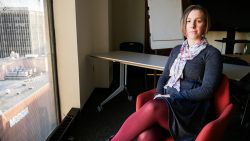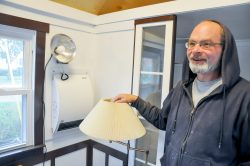For Wisconsin’s homeless, things are looking up, thanks to revitalized services and out-of-the-box solutions. To many, these are the first steps to a place of their own
It is not something he would wish on anyone else, but it is his reality. A survival mode like no other, it is a vicious cycle that is easy to fall into and nearly impossible to escape.
Bob VanKampen, 57, endures the cycle of homelessness every 24 hours. It throws him around and hits him where it hurts, but it does not keep him down.
After 12 years on the streets, VanKampen finally has the keys to his own home.
In the city of ‘forward’
Madison has formed a unique coalition of services and alternative approaches to end the housing crisis that forces more than 500 people onto the streets every night. These revamped channels focus on individualized services that recognize each person’s story.
In the last decade, the federal government refined and standardized approaches to prevent and end homelessness across the nation. On the whole, chronic homelessness declined by 35 percent between 2007 and 2016. This number declined by 7 percent between 2015 and 2016 alone. In Wisconsin, the overall homelessness rate has fallen 10.2 percent since 2010.
Outreach efforts in Madison now look at the causes of homelessness on a case-by-case basis. This allows those trying to help to understand the unique obstacles that prevent people from finding homes and pinpoints what each homeless person needs to move forward.
Madison has homeless futures in mind. The homeless child in the shelters has someone helping them get to college, the mother on the corner has someone to lend her a hand and the apartment next door could soon be a displaced veteran’s new home.
Madison has homeless futures in mind, which means the homeless child in the shelters has someone helping them get to college, the mother on the corner has someone to lend her a hand and the apartment next door could soon be a displaced veteran’s new home.
A roof overhead
The transformation of Madison’s approach to homelessness started in the mid-2000s by testing a housing-first policy. Housing first offers homeless individuals and families immediate access to permanent or supportive housing, with fewer and lower barriers to entry. People can move into housing without the pressure of sobriety, employment or treatment requirements. Instead, they work on getting help through housing-provided services once they have a roof over their heads. In 2017, housing first is the community standard.

Torrie Kopp Mueller, 38, is the continuum of care coordinator for the Homeless Services Consortium. She was hired to streamline housing resources and get people into housing as quickly and efficiently as possible. To Kopp Mueller, housing first is the obvious choice.
“Getting housing is the big thing. It’s really hard to reach goals when you don’t know exactly where you’re going to be at night,” she says.
The lone wolf problem
Although housing first is a step forward for placing the homeless, it is a daunting task to those who face it alone.
In Dane County, the most critical homeless demographics are veterans, children, families and those who are chronically homeless.2 Chronic homelessness occurs when a person has been without residence for more than one year. Individuals, or singles,3 experiencing homelessness are often left behind. They are at the bottom of every priority housing list, receiving little to no assistance and scraping together whatever resources are left after more urgent needs are met. Wisconsin has experienced the fourth largest increase of homeless individuals from 2007 to 2016, nationwide.
Gene Cox, 44, lived out of his van for over a year and parked in a south Madison Walmart parking lot before moving for a time to a park-and-ride lot. He is a markedly positive person, with a hearty laugh, a jolly grin and a tendency to put others first. He navigated homelessness alone and struggled to find solid help.
“Getting connected with resources is very tough. The only thing I had going for me, as far as getting connected to resources, was that I was a veteran,” Cox says. “I haven’t been diagnosed with any mental illness. I was getting close to what they consider chronic homelessness, but it seems like there’s always somebody worse off that needs it more.”


It took VanKampen more than a decade to put his military status on his housing applications because he did not realize that veteran services would put him first despite being on his own. He has his fingers crossed that his service to the country will boost his chances of getting into housing.
VanKampen supports housing first because, like Cox, he’s a lone wolf. He feels that once he has housing, he can go forward with finding a job and work toward eventually renting his own home. Right now, he feels exhausted just thinking about job applications. His priority, like many other homeless people, is on day-to-day subsistence. He describes his current occupation as “survivor,” and he does it alone.
It takes a village
The hierarchy of homeless needs and the system of “who needs it the most” leaves a lot of people to fend for themselves. One way Madison has found to address the overwhelming number of singles is through Tiny Village, an alternative living setup established by the nonprofit Occupy Madison in 2014 that uses cheap and mobile micro homes.
Standing at the corner of East Johnson Street and North Third Street on Madison’s east side, the village community is made up of individuals who live in their own personalized cabins on wheels. They do not pay rent, but instead cover their living costs with “sweat equity.” Community members maintain the homes and the site by woodworking, gardening and contributing to a food share among residents. They also demonstrate their talents in jewelry-making, weaving and beekeeping to stock the Tiny Village merchandise store, which funds the community with sales.
The village’s approach to preventing and ending individual homelessness gives previously unsheltered people a purpose — something Cox, who is now a resident, calls a “meaningful occupation.” Cox says living out of his van isolated him from others. Now, he feels like part of a community, and more deeply, he feels useful to others experiencing homelessness.
“On a deeper level, it’s really about making connections with people because we’re so isolated,” Cox says. “That can make a world of difference, just having community.”
Below the surface

A darker facet of homelessness is not so easily solved with physical resources and community building. Nearly one-fifth of Madison’s homeless population struggles with more than economic disparities and social isolation. Mental illness adds a complex barrier to getting a home.
Michael Basford, Associate Executive Director at Housing Initiatives, Madison’s only organization that exclusively provides permanent supportive housing for the mentally ill homeless population, remembers one anonymous homeless woman who lived off the Capitol Square for years. Every night of every season, she bundled up to sleep outside. Even in extreme weather, she avoided the emergency shelters. The service organization network heard about her and immediately took action. It took them a long time to locate her. It took them even longer to understand that her severe paranoia made it difficult for her to trust others.
Basford cites an increase in the number of outreach workers as a key step to not only finding individuals with mental illness on the streets, but in building the trust that will guide them to the resources they need.
With a 95 percent permanent housing success rate, the organization prevents most of its clients from ever going back to the streets. Still, outreach services like these fail if there is no permanent housing accessible after treatment.
No vacancy

Sarah Lim, 38, works for the City of Madison with Kopp Mueller. As a community development specialist in homeless services, she handles budget allocations for the city’s homeless programs, including housing. She heard about the same woman with mental illness through her nonprofit networks and followed her story. Lim says that when the woman finally connected with housing resources, her mental illness did not just go away, but it was a start.
“She thought people were out to get her, that kind of thing. But when she was actually offered her own place, she tried it out,” Lim says. “I would say there are not that many people who have mental illness serious enough — the paranoia serious enough — to refuse permanent housing that is provided to them. But even her, even she took it.”
Madison lacks the necessary affordable housing for this kind of homeless reintegration.
A person would have to earn $16.11 an hour or work 89 hours a week at the $7.25 minimum wage to afford a two-bedroom rental home in Wisconsin. Some homeless folks have jobs while they are displaced or find jobs after they are in housing, but the cost of living alone negates their wages and makes it nearly impossible to pay rent or save for a home. Combined with upscale developments, such as the luxury apartment boom downtown, there are not enough attainable homes for the displaced.
VanKampen acknowledges his poor credit score, as well as the decades he will have to put in at minimum-wage in order to improve it. He is almost retirement age, but plans to work until he is more than 80 years old if that is what it takes to afford his dream: owning his own home.
All ways home
Despite the many unique challenges to its homeless population, Madison has made institutional changes that create new city-wide opportunities for people on the streets. The city partners with private organizations to establish modern shelters that provide updated services.
![]()
In October, The Beacon opened on East Washington Street in Madison to provide daytime resources to the homeless. United Way of Dane County, a community development charity, Catholic Charities, a nonprofit social services agency, and the City of Madison came together to construct and operate The Beacon. Visitors can access laundry machines, computer labs, private showers, individual lockers and private family quarters, including breastfeeding rooms. A city day shelter in Madison hasn’t been this modern or full of hope in years. For the city’s services and programs, continual system refinement and community efforts contribute to homeless progress.
Still, it is the people who are homeless who ultimately define their own progress as a displaced community seeking permanent housing. Their successes don’t come in leaps and bounds, but in small steps that lead to something big.
Once living out of his van, Cox now has a permanent mailing address at Tiny Village. He just opened his first mailed paycheck in a year. After a long period of working with one struggling family, Kopp Mueller watched them enroll the kids in swim lessons and get library cards together. They go to the library a lot now. The scared, wandering homeless woman trusted outreach services enough to accept their help. She has stabilized her condition since being in housing. This will be her second consecutive winter in housing.
As for VanKampen, he has been approved for housing through the Porchlight Inc. Veteran’s Transitional Housing Program. After more than 10 years on and off the streets and one year of continuous homelessness, VanKampen has the keys to his own private living unit. He can’t stop smiling as he talks about it.
“What’s next for Bob is getting into an apartment, close the door and lock it,” he says.

Angie is a senior majoring in journalism with a focus in strategic communication, she is also pursuing a certificate in digital studies.
She is a barista at a State Street cafe, manages social media for Community Shares of Wisconsin — a local nonprofit — and serves as senior class co-chair for the Powers-Knapp Scholarship Program.
In her spare time, she scopes out deals at local thrift stores, consumes impressive amounts of hot sauce and builds fresh Spotify playlists. One day, Angie wants to start and run her own business, either an ethical design agency or a Mexican restaurant.

